Financial Accounting Report: Stakeholders, Final Accounts, Tasks
VerifiedAdded on 2023/01/06
|22
|3838
|29
Report
AI Summary
This report delves into the core concepts of financial accounting, emphasizing its role in tracking and interpreting an organization's financial transactions. It explores the purpose of financial accounting, including the preparation of financial statements like profit and loss accounts and balance sheets. The report is divided into two main tasks. The first task defines financial accounting, outlines its characteristics, and examines the roles of various stakeholders, both internal (owners, management) and external (investors, government, creditors, society). The second task focuses on practical application, demonstrating the double-entry accounting system, the preparation of final accounts, and the understanding of bank reconciliation statements and suspense accounts. The report provides detailed examples and practical applications to enhance the understanding of financial accounting principles.

Financial Accounting
1
1
Paraphrase This Document
Need a fresh take? Get an instant paraphrase of this document with our AI Paraphraser
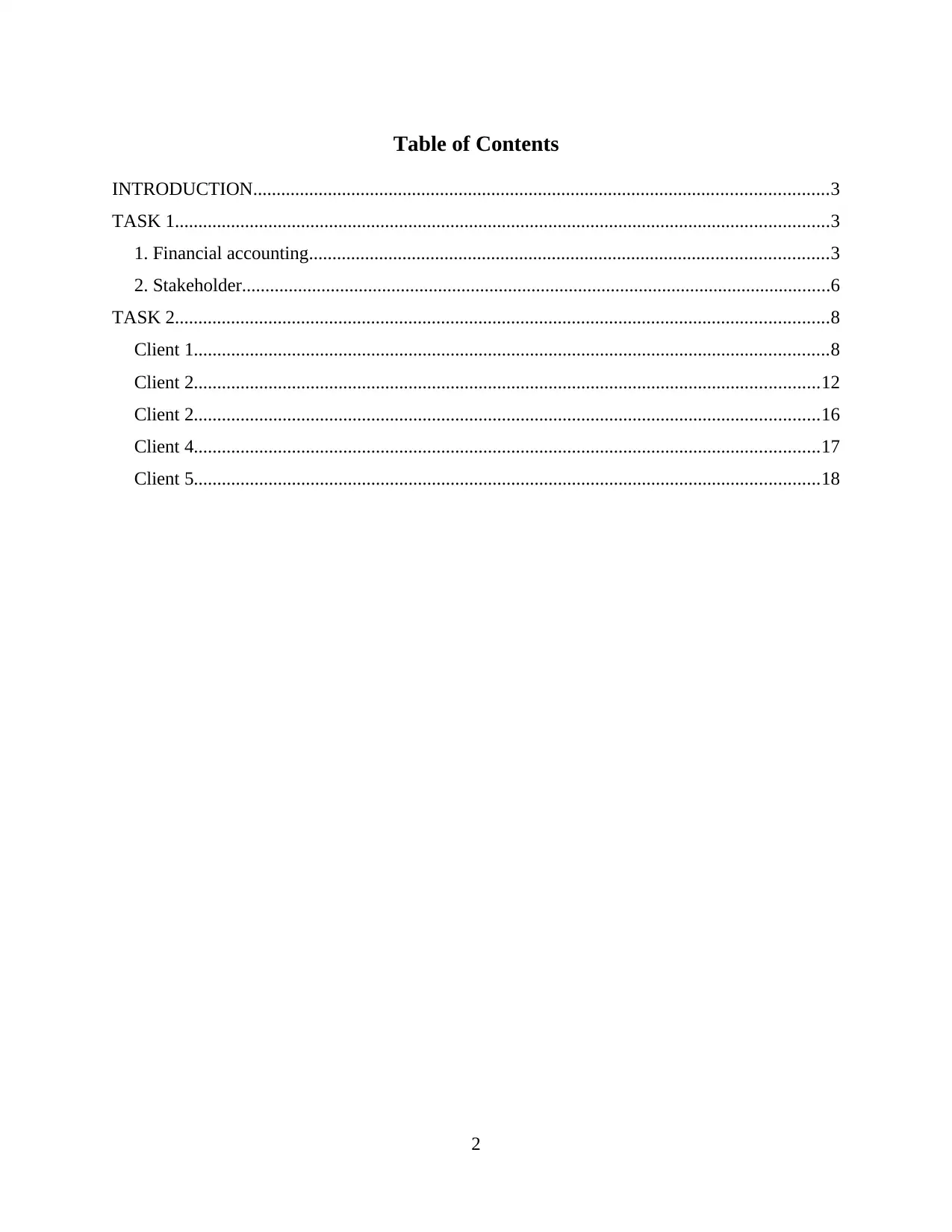
Table of Contents
INTRODUCTION...........................................................................................................................3
TASK 1............................................................................................................................................3
1. Financial accounting...............................................................................................................3
2. Stakeholder..............................................................................................................................6
TASK 2............................................................................................................................................8
Client 1........................................................................................................................................8
Client 2......................................................................................................................................12
Client 2......................................................................................................................................16
Client 4......................................................................................................................................17
Client 5......................................................................................................................................18
2
INTRODUCTION...........................................................................................................................3
TASK 1............................................................................................................................................3
1. Financial accounting...............................................................................................................3
2. Stakeholder..............................................................................................................................6
TASK 2............................................................................................................................................8
Client 1........................................................................................................................................8
Client 2......................................................................................................................................12
Client 2......................................................................................................................................16
Client 4......................................................................................................................................17
Client 5......................................................................................................................................18
2
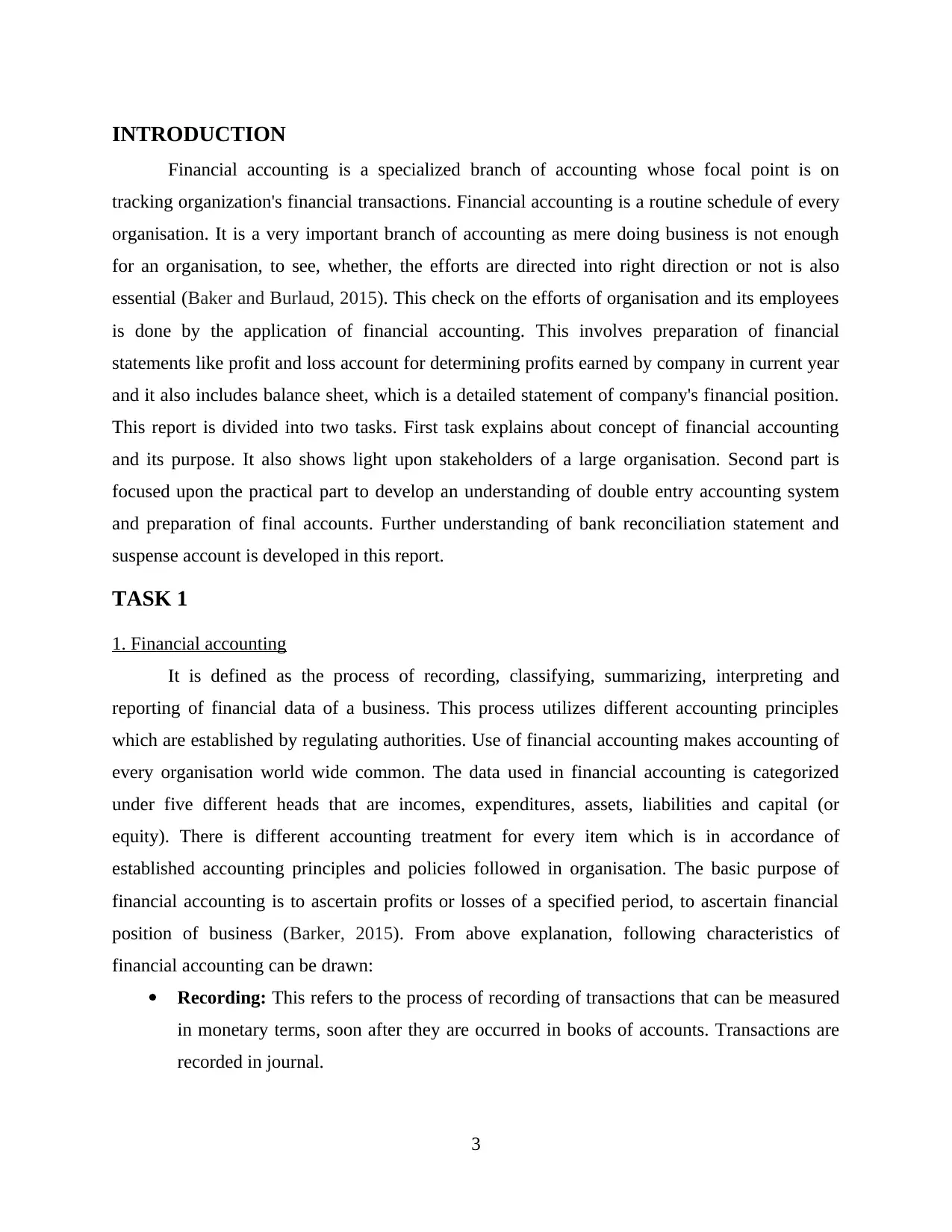
INTRODUCTION
Financial accounting is a specialized branch of accounting whose focal point is on
tracking organization's financial transactions. Financial accounting is a routine schedule of every
organisation. It is a very important branch of accounting as mere doing business is not enough
for an organisation, to see, whether, the efforts are directed into right direction or not is also
essential (Baker and Burlaud, 2015). This check on the efforts of organisation and its employees
is done by the application of financial accounting. This involves preparation of financial
statements like profit and loss account for determining profits earned by company in current year
and it also includes balance sheet, which is a detailed statement of company's financial position.
This report is divided into two tasks. First task explains about concept of financial accounting
and its purpose. It also shows light upon stakeholders of a large organisation. Second part is
focused upon the practical part to develop an understanding of double entry accounting system
and preparation of final accounts. Further understanding of bank reconciliation statement and
suspense account is developed in this report.
TASK 1
1. Financial accounting
It is defined as the process of recording, classifying, summarizing, interpreting and
reporting of financial data of a business. This process utilizes different accounting principles
which are established by regulating authorities. Use of financial accounting makes accounting of
every organisation world wide common. The data used in financial accounting is categorized
under five different heads that are incomes, expenditures, assets, liabilities and capital (or
equity). There is different accounting treatment for every item which is in accordance of
established accounting principles and policies followed in organisation. The basic purpose of
financial accounting is to ascertain profits or losses of a specified period, to ascertain financial
position of business (Barker, 2015). From above explanation, following characteristics of
financial accounting can be drawn:
Recording: This refers to the process of recording of transactions that can be measured
in monetary terms, soon after they are occurred in books of accounts. Transactions are
recorded in journal.
3
Financial accounting is a specialized branch of accounting whose focal point is on
tracking organization's financial transactions. Financial accounting is a routine schedule of every
organisation. It is a very important branch of accounting as mere doing business is not enough
for an organisation, to see, whether, the efforts are directed into right direction or not is also
essential (Baker and Burlaud, 2015). This check on the efforts of organisation and its employees
is done by the application of financial accounting. This involves preparation of financial
statements like profit and loss account for determining profits earned by company in current year
and it also includes balance sheet, which is a detailed statement of company's financial position.
This report is divided into two tasks. First task explains about concept of financial accounting
and its purpose. It also shows light upon stakeholders of a large organisation. Second part is
focused upon the practical part to develop an understanding of double entry accounting system
and preparation of final accounts. Further understanding of bank reconciliation statement and
suspense account is developed in this report.
TASK 1
1. Financial accounting
It is defined as the process of recording, classifying, summarizing, interpreting and
reporting of financial data of a business. This process utilizes different accounting principles
which are established by regulating authorities. Use of financial accounting makes accounting of
every organisation world wide common. The data used in financial accounting is categorized
under five different heads that are incomes, expenditures, assets, liabilities and capital (or
equity). There is different accounting treatment for every item which is in accordance of
established accounting principles and policies followed in organisation. The basic purpose of
financial accounting is to ascertain profits or losses of a specified period, to ascertain financial
position of business (Barker, 2015). From above explanation, following characteristics of
financial accounting can be drawn:
Recording: This refers to the process of recording of transactions that can be measured
in monetary terms, soon after they are occurred in books of accounts. Transactions are
recorded in journal.
3
⊘ This is a preview!⊘
Do you want full access?
Subscribe today to unlock all pages.

Trusted by 1+ million students worldwide

Classifying: It is concerned with the classification of the recorded data in a way that
similar nature of transactions are grouped under common head (Cooper, 2017).
Summarising: It is focused on presentation of classified data in a manner that is useful
for users. This step of financial accounting involves preparation of financial statements
such as profit and loss account, balance sheet, cash flow statement, etc.
Interpreting: After all above mentioned functions are performed, interpreting comes in
role, it means communication of results derived to managers after interpreting them.
This interpretation includes questions like (a) why it happened (b) what can happen in
coming time.
Financial accounting is an art and science as well: Accounting is an art as some of
the decisions are based on the personal judgement of accountant and it is a science as,
universally, books of accounts are prepared in similar nature based on accounting
principles that are followed by every accountant.
There are various branches under accounting, but they all differ in their functions and roles. In
order to explain above statement, difference between financial accounting and management
accounting is given below (Drew and Dollery, 2015):
Basis Financial accounting Management accounting
Meaning It refers to the mathematical
operations carried on raw monetary
data, in order to present them in a
systematic and meaningful manner.
It refers to the steps and analysis
conducted on results of operation of
financial accounting. This is done with
the purpose of obtaining assisting
source for strategy formulation.
Users Both internal and external users have
access to financial accounting. This
is given in annual reports of
company.
This is done only for the use of
internal users, as, it assists them to
plan for future course of actions.
Purpose of financial accounting: To keep systematic records- Financial accounting is performed with basic purpose of
maintaining systematic records. If accounting is not performed, than it will create a huge
4
similar nature of transactions are grouped under common head (Cooper, 2017).
Summarising: It is focused on presentation of classified data in a manner that is useful
for users. This step of financial accounting involves preparation of financial statements
such as profit and loss account, balance sheet, cash flow statement, etc.
Interpreting: After all above mentioned functions are performed, interpreting comes in
role, it means communication of results derived to managers after interpreting them.
This interpretation includes questions like (a) why it happened (b) what can happen in
coming time.
Financial accounting is an art and science as well: Accounting is an art as some of
the decisions are based on the personal judgement of accountant and it is a science as,
universally, books of accounts are prepared in similar nature based on accounting
principles that are followed by every accountant.
There are various branches under accounting, but they all differ in their functions and roles. In
order to explain above statement, difference between financial accounting and management
accounting is given below (Drew and Dollery, 2015):
Basis Financial accounting Management accounting
Meaning It refers to the mathematical
operations carried on raw monetary
data, in order to present them in a
systematic and meaningful manner.
It refers to the steps and analysis
conducted on results of operation of
financial accounting. This is done with
the purpose of obtaining assisting
source for strategy formulation.
Users Both internal and external users have
access to financial accounting. This
is given in annual reports of
company.
This is done only for the use of
internal users, as, it assists them to
plan for future course of actions.
Purpose of financial accounting: To keep systematic records- Financial accounting is performed with basic purpose of
maintaining systematic records. If accounting is not performed, than it will create a huge
4
Paraphrase This Document
Need a fresh take? Get an instant paraphrase of this document with our AI Paraphraser
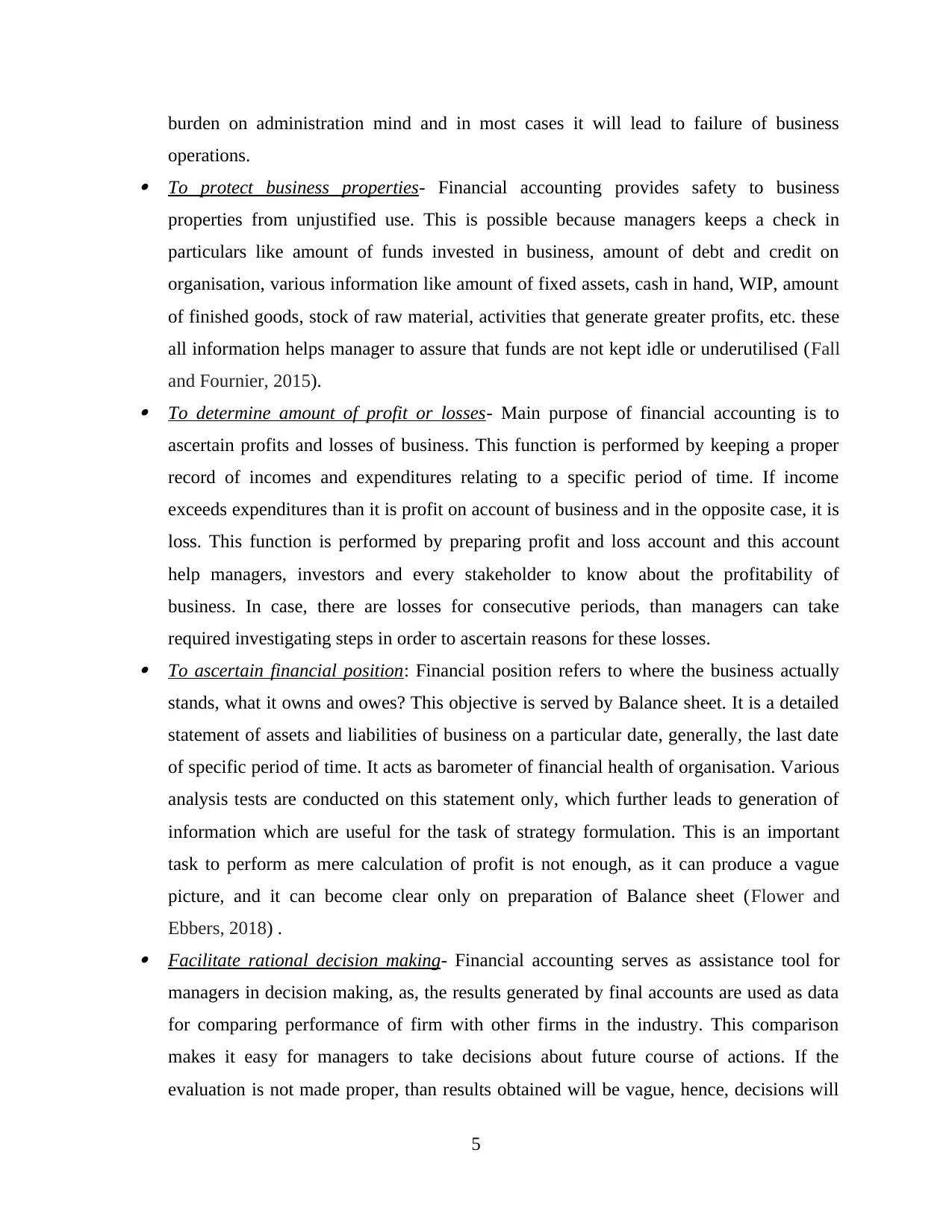
burden on administration mind and in most cases it will lead to failure of business
operations. To protect business properties- Financial accounting provides safety to business
properties from unjustified use. This is possible because managers keeps a check in
particulars like amount of funds invested in business, amount of debt and credit on
organisation, various information like amount of fixed assets, cash in hand, WIP, amount
of finished goods, stock of raw material, activities that generate greater profits, etc. these
all information helps manager to assure that funds are not kept idle or underutilised (Fall
and Fournier, 2015). To determine amount of profit or losses- Main purpose of financial accounting is to
ascertain profits and losses of business. This function is performed by keeping a proper
record of incomes and expenditures relating to a specific period of time. If income
exceeds expenditures than it is profit on account of business and in the opposite case, it is
loss. This function is performed by preparing profit and loss account and this account
help managers, investors and every stakeholder to know about the profitability of
business. In case, there are losses for consecutive periods, than managers can take
required investigating steps in order to ascertain reasons for these losses. To ascertain financial position: Financial position refers to where the business actually
stands, what it owns and owes? This objective is served by Balance sheet. It is a detailed
statement of assets and liabilities of business on a particular date, generally, the last date
of specific period of time. It acts as barometer of financial health of organisation. Various
analysis tests are conducted on this statement only, which further leads to generation of
information which are useful for the task of strategy formulation. This is an important
task to perform as mere calculation of profit is not enough, as it can produce a vague
picture, and it can become clear only on preparation of Balance sheet (Flower and
Ebbers, 2018) . Facilitate rational decision making- Financial accounting serves as assistance tool for
managers in decision making, as, the results generated by final accounts are used as data
for comparing performance of firm with other firms in the industry. This comparison
makes it easy for managers to take decisions about future course of actions. If the
evaluation is not made proper, than results obtained will be vague, hence, decisions will
5
operations. To protect business properties- Financial accounting provides safety to business
properties from unjustified use. This is possible because managers keeps a check in
particulars like amount of funds invested in business, amount of debt and credit on
organisation, various information like amount of fixed assets, cash in hand, WIP, amount
of finished goods, stock of raw material, activities that generate greater profits, etc. these
all information helps manager to assure that funds are not kept idle or underutilised (Fall
and Fournier, 2015). To determine amount of profit or losses- Main purpose of financial accounting is to
ascertain profits and losses of business. This function is performed by keeping a proper
record of incomes and expenditures relating to a specific period of time. If income
exceeds expenditures than it is profit on account of business and in the opposite case, it is
loss. This function is performed by preparing profit and loss account and this account
help managers, investors and every stakeholder to know about the profitability of
business. In case, there are losses for consecutive periods, than managers can take
required investigating steps in order to ascertain reasons for these losses. To ascertain financial position: Financial position refers to where the business actually
stands, what it owns and owes? This objective is served by Balance sheet. It is a detailed
statement of assets and liabilities of business on a particular date, generally, the last date
of specific period of time. It acts as barometer of financial health of organisation. Various
analysis tests are conducted on this statement only, which further leads to generation of
information which are useful for the task of strategy formulation. This is an important
task to perform as mere calculation of profit is not enough, as it can produce a vague
picture, and it can become clear only on preparation of Balance sheet (Flower and
Ebbers, 2018) . Facilitate rational decision making- Financial accounting serves as assistance tool for
managers in decision making, as, the results generated by final accounts are used as data
for comparing performance of firm with other firms in the industry. This comparison
makes it easy for managers to take decisions about future course of actions. If the
evaluation is not made proper, than results obtained will be vague, hence, decisions will
5
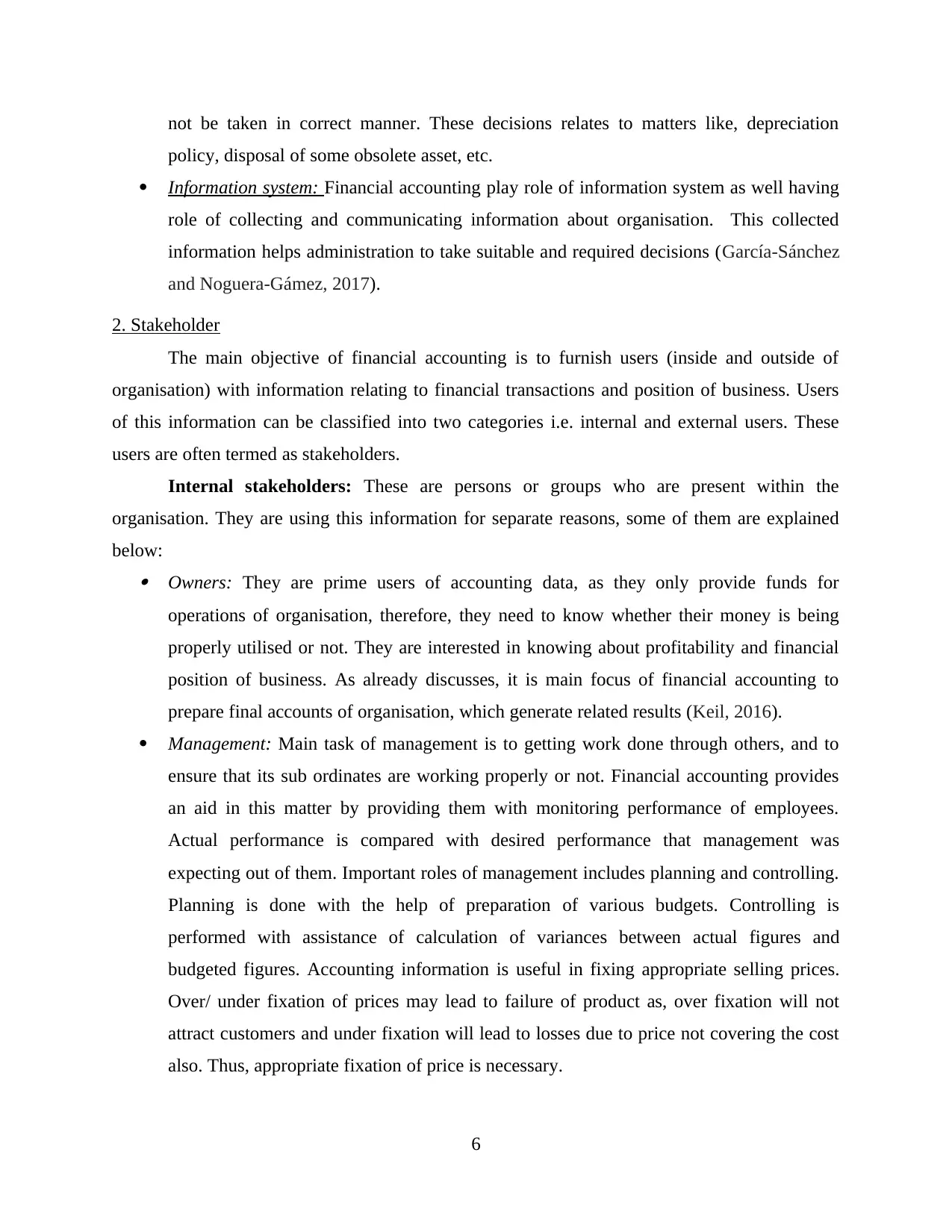
not be taken in correct manner. These decisions relates to matters like, depreciation
policy, disposal of some obsolete asset, etc.
Information system: Financial accounting play role of information system as well having
role of collecting and communicating information about organisation. This collected
information helps administration to take suitable and required decisions (García‐Sánchez
and Noguera‐Gámez, 2017).
2. Stakeholder
The main objective of financial accounting is to furnish users (inside and outside of
organisation) with information relating to financial transactions and position of business. Users
of this information can be classified into two categories i.e. internal and external users. These
users are often termed as stakeholders.
Internal stakeholders: These are persons or groups who are present within the
organisation. They are using this information for separate reasons, some of them are explained
below: Owners: They are prime users of accounting data, as they only provide funds for
operations of organisation, therefore, they need to know whether their money is being
properly utilised or not. They are interested in knowing about profitability and financial
position of business. As already discusses, it is main focus of financial accounting to
prepare final accounts of organisation, which generate related results (Keil, 2016).
Management: Main task of management is to getting work done through others, and to
ensure that its sub ordinates are working properly or not. Financial accounting provides
an aid in this matter by providing them with monitoring performance of employees.
Actual performance is compared with desired performance that management was
expecting out of them. Important roles of management includes planning and controlling.
Planning is done with the help of preparation of various budgets. Controlling is
performed with assistance of calculation of variances between actual figures and
budgeted figures. Accounting information is useful in fixing appropriate selling prices.
Over/ under fixation of prices may lead to failure of product as, over fixation will not
attract customers and under fixation will lead to losses due to price not covering the cost
also. Thus, appropriate fixation of price is necessary.
6
policy, disposal of some obsolete asset, etc.
Information system: Financial accounting play role of information system as well having
role of collecting and communicating information about organisation. This collected
information helps administration to take suitable and required decisions (García‐Sánchez
and Noguera‐Gámez, 2017).
2. Stakeholder
The main objective of financial accounting is to furnish users (inside and outside of
organisation) with information relating to financial transactions and position of business. Users
of this information can be classified into two categories i.e. internal and external users. These
users are often termed as stakeholders.
Internal stakeholders: These are persons or groups who are present within the
organisation. They are using this information for separate reasons, some of them are explained
below: Owners: They are prime users of accounting data, as they only provide funds for
operations of organisation, therefore, they need to know whether their money is being
properly utilised or not. They are interested in knowing about profitability and financial
position of business. As already discusses, it is main focus of financial accounting to
prepare final accounts of organisation, which generate related results (Keil, 2016).
Management: Main task of management is to getting work done through others, and to
ensure that its sub ordinates are working properly or not. Financial accounting provides
an aid in this matter by providing them with monitoring performance of employees.
Actual performance is compared with desired performance that management was
expecting out of them. Important roles of management includes planning and controlling.
Planning is done with the help of preparation of various budgets. Controlling is
performed with assistance of calculation of variances between actual figures and
budgeted figures. Accounting information is useful in fixing appropriate selling prices.
Over/ under fixation of prices may lead to failure of product as, over fixation will not
attract customers and under fixation will lead to losses due to price not covering the cost
also. Thus, appropriate fixation of price is necessary.
6
⊘ This is a preview!⊘
Do you want full access?
Subscribe today to unlock all pages.

Trusted by 1+ million students worldwide
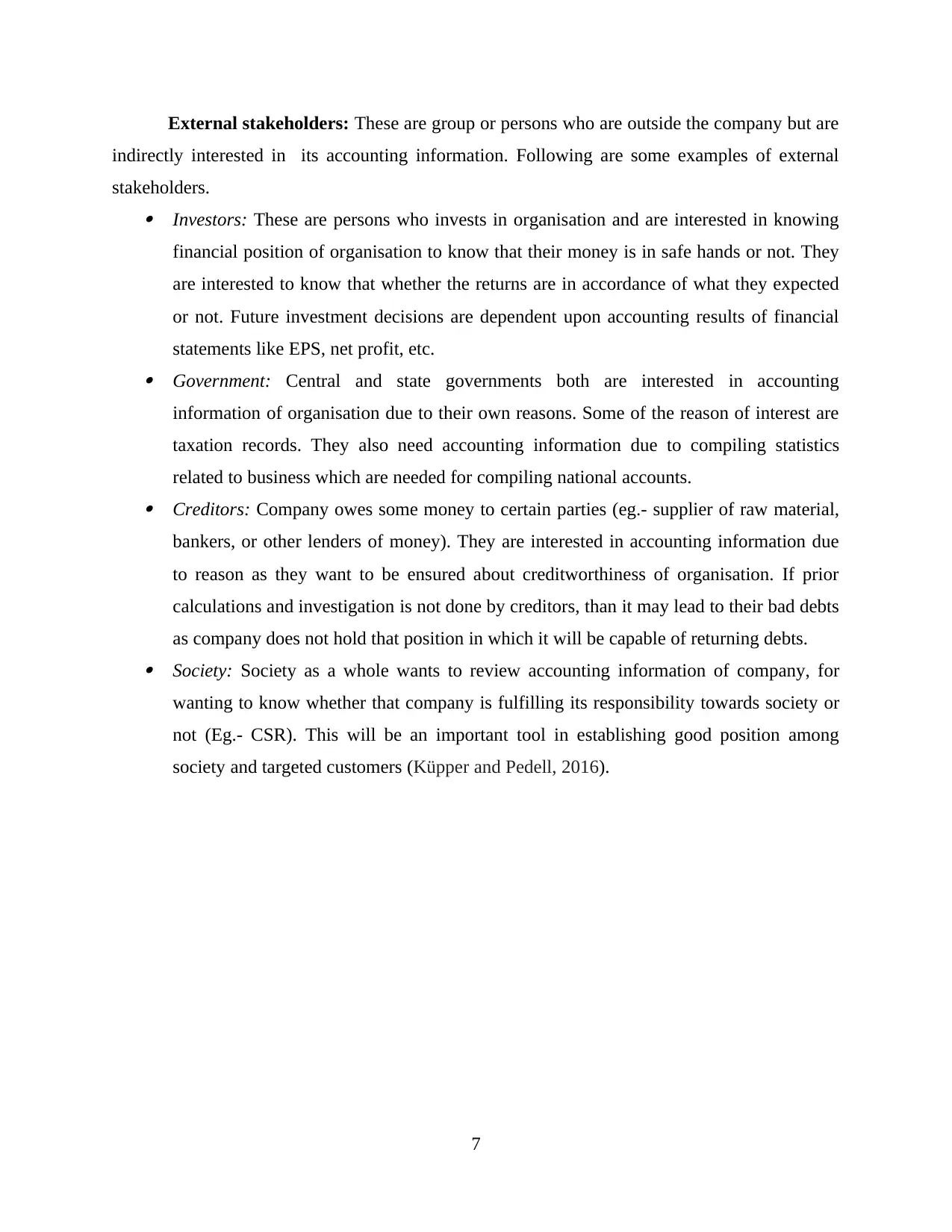
External stakeholders: These are group or persons who are outside the company but are
indirectly interested in its accounting information. Following are some examples of external
stakeholders. Investors: These are persons who invests in organisation and are interested in knowing
financial position of organisation to know that their money is in safe hands or not. They
are interested to know that whether the returns are in accordance of what they expected
or not. Future investment decisions are dependent upon accounting results of financial
statements like EPS, net profit, etc. Government: Central and state governments both are interested in accounting
information of organisation due to their own reasons. Some of the reason of interest are
taxation records. They also need accounting information due to compiling statistics
related to business which are needed for compiling national accounts. Creditors: Company owes some money to certain parties (eg.- supplier of raw material,
bankers, or other lenders of money). They are interested in accounting information due
to reason as they want to be ensured about creditworthiness of organisation. If prior
calculations and investigation is not done by creditors, than it may lead to their bad debts
as company does not hold that position in which it will be capable of returning debts. Society: Society as a whole wants to review accounting information of company, for
wanting to know whether that company is fulfilling its responsibility towards society or
not (Eg.- CSR). This will be an important tool in establishing good position among
society and targeted customers (Küpper and Pedell, 2016).
7
indirectly interested in its accounting information. Following are some examples of external
stakeholders. Investors: These are persons who invests in organisation and are interested in knowing
financial position of organisation to know that their money is in safe hands or not. They
are interested to know that whether the returns are in accordance of what they expected
or not. Future investment decisions are dependent upon accounting results of financial
statements like EPS, net profit, etc. Government: Central and state governments both are interested in accounting
information of organisation due to their own reasons. Some of the reason of interest are
taxation records. They also need accounting information due to compiling statistics
related to business which are needed for compiling national accounts. Creditors: Company owes some money to certain parties (eg.- supplier of raw material,
bankers, or other lenders of money). They are interested in accounting information due
to reason as they want to be ensured about creditworthiness of organisation. If prior
calculations and investigation is not done by creditors, than it may lead to their bad debts
as company does not hold that position in which it will be capable of returning debts. Society: Society as a whole wants to review accounting information of company, for
wanting to know whether that company is fulfilling its responsibility towards society or
not (Eg.- CSR). This will be an important tool in establishing good position among
society and targeted customers (Küpper and Pedell, 2016).
7
Paraphrase This Document
Need a fresh take? Get an instant paraphrase of this document with our AI Paraphraser
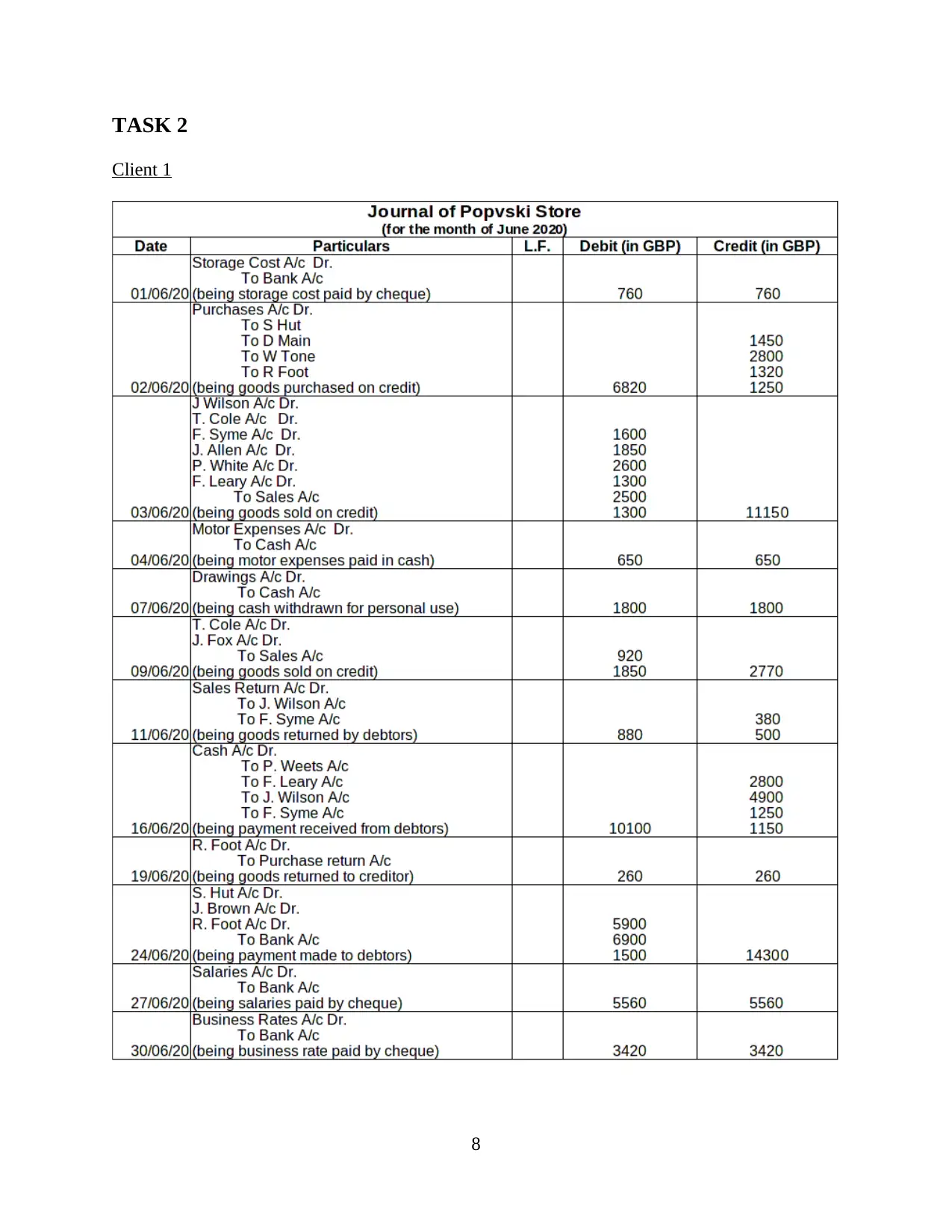
TASK 2
Client 1
8
Client 1
8
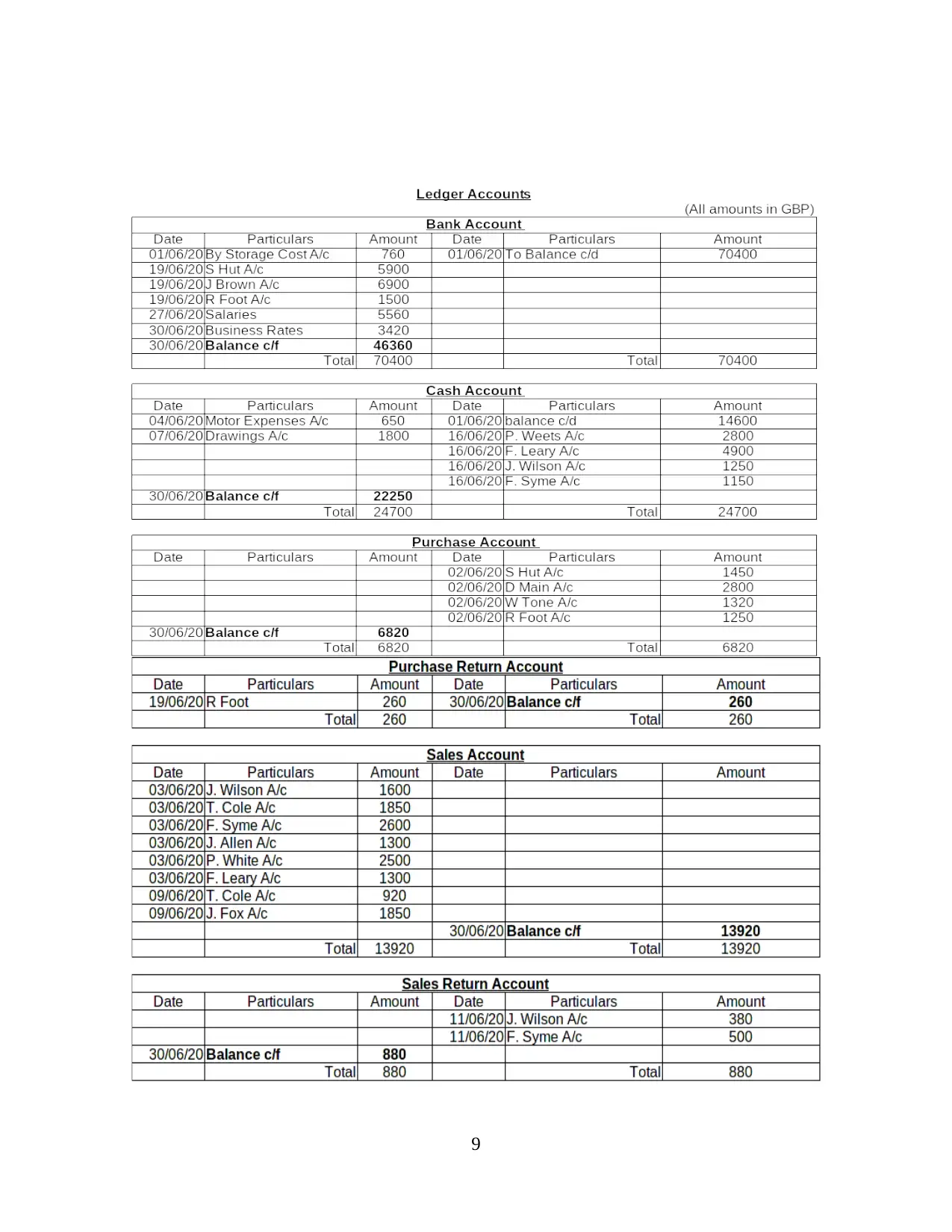
9
⊘ This is a preview!⊘
Do you want full access?
Subscribe today to unlock all pages.

Trusted by 1+ million students worldwide
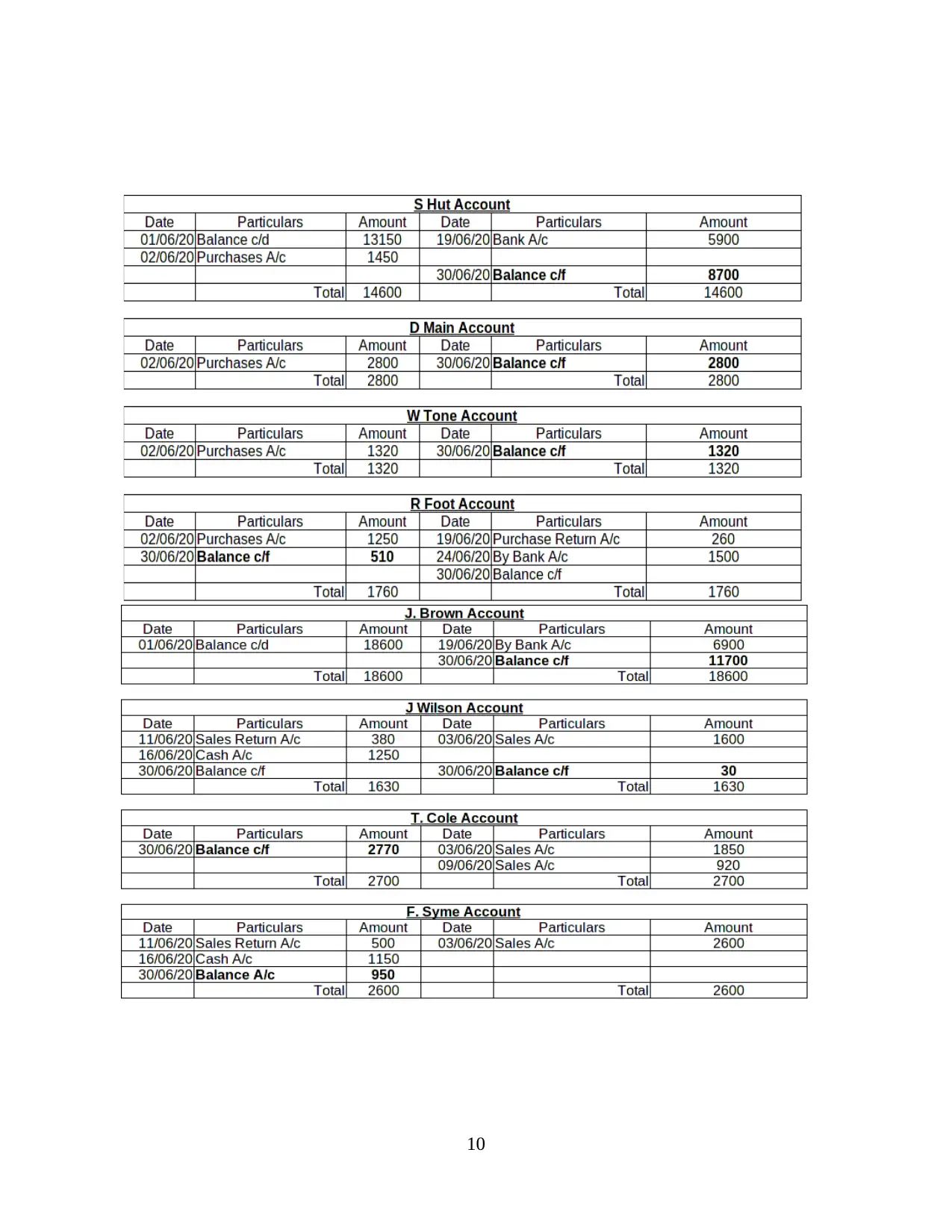
10
Paraphrase This Document
Need a fresh take? Get an instant paraphrase of this document with our AI Paraphraser
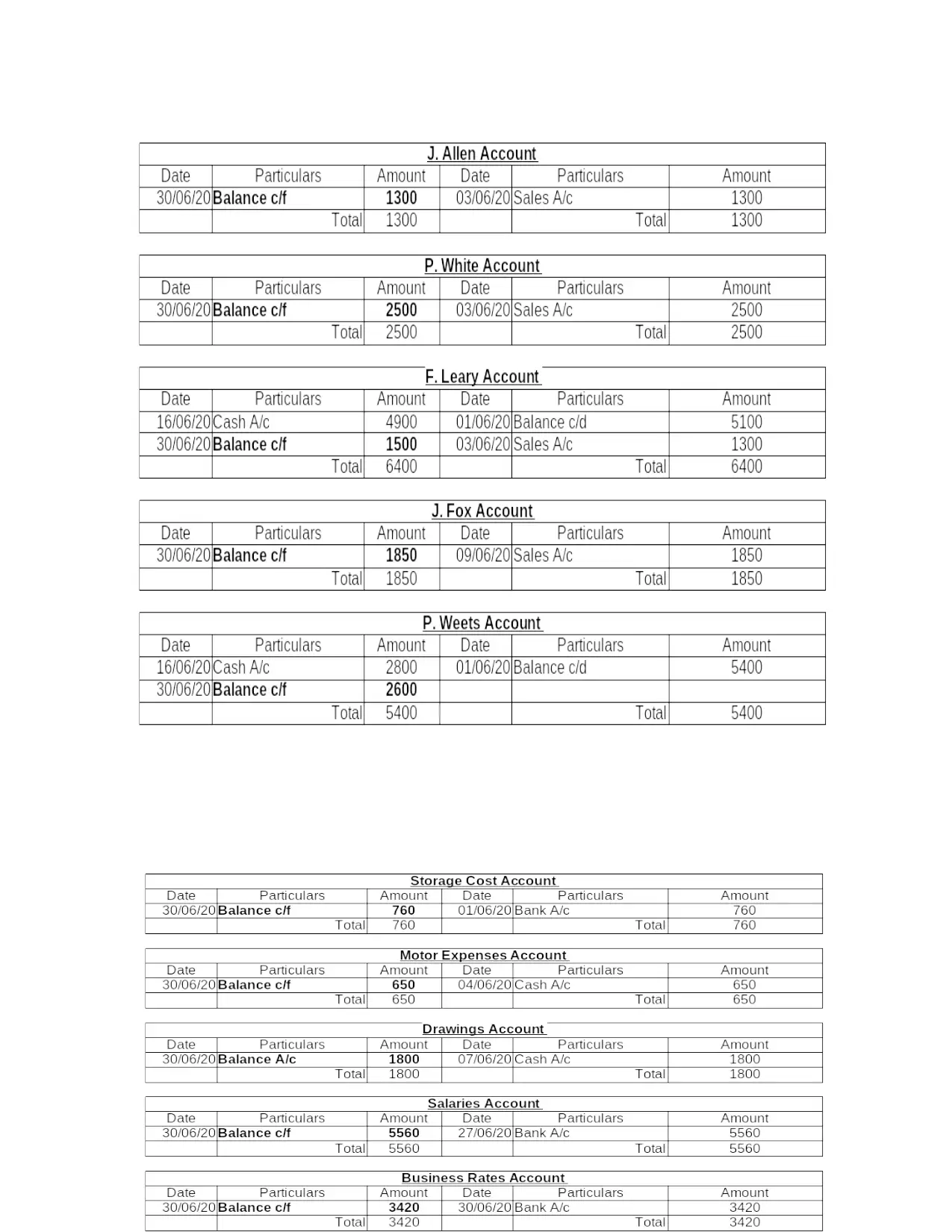
11
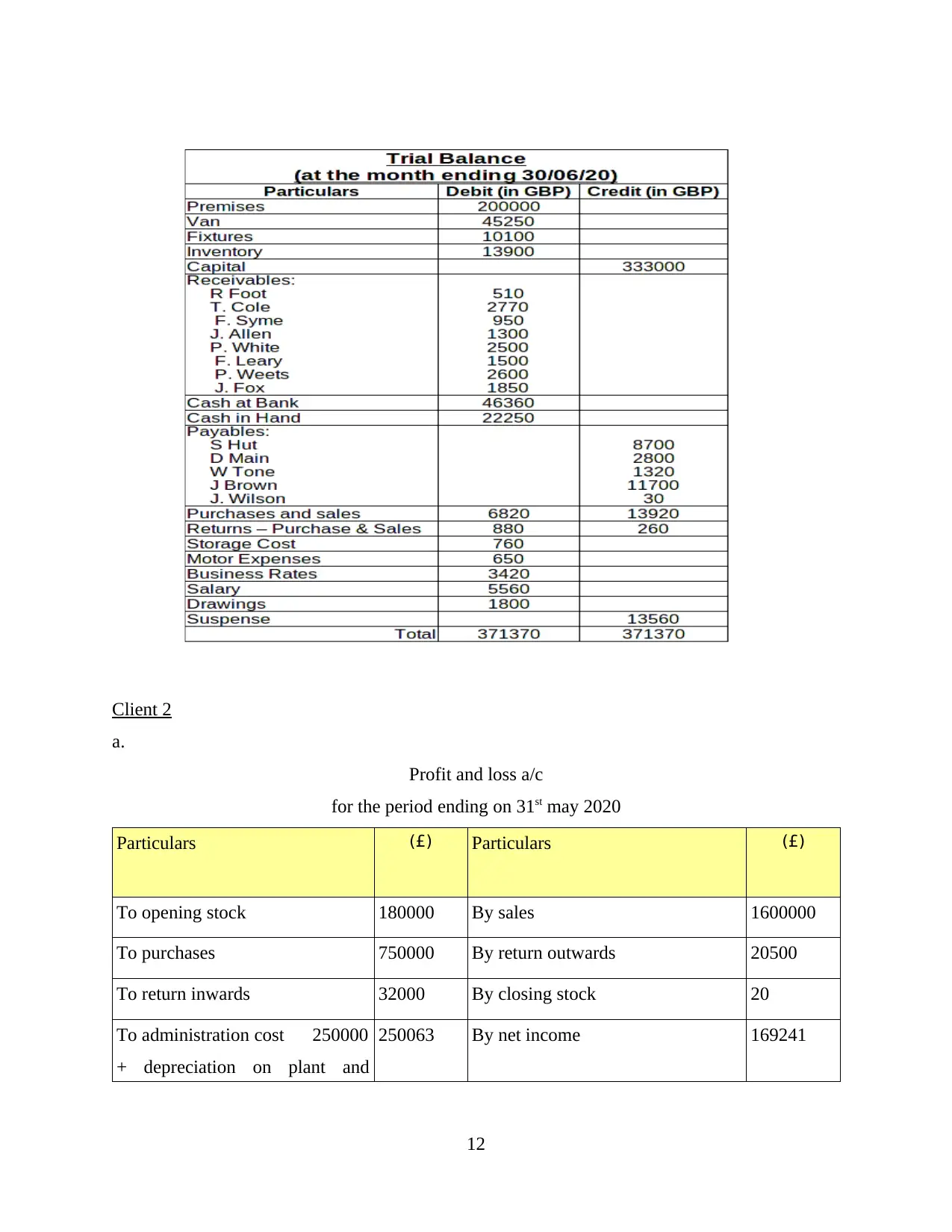
Client 2
a.
Profit and loss a/c
for the period ending on 31st may 2020
Particulars (£) Particulars (£)
To opening stock 180000 By sales 1600000
To purchases 750000 By return outwards 20500
To return inwards 32000 By closing stock 20
To administration cost 250000
+ depreciation on plant and
250063 By net income 169241
12
a.
Profit and loss a/c
for the period ending on 31st may 2020
Particulars (£) Particulars (£)
To opening stock 180000 By sales 1600000
To purchases 750000 By return outwards 20500
To return inwards 32000 By closing stock 20
To administration cost 250000
+ depreciation on plant and
250063 By net income 169241
12
⊘ This is a preview!⊘
Do you want full access?
Subscribe today to unlock all pages.

Trusted by 1+ million students worldwide
1 out of 22
Related Documents
Your All-in-One AI-Powered Toolkit for Academic Success.
+13062052269
info@desklib.com
Available 24*7 on WhatsApp / Email
![[object Object]](/_next/static/media/star-bottom.7253800d.svg)
Unlock your academic potential
Copyright © 2020–2025 A2Z Services. All Rights Reserved. Developed and managed by ZUCOL.





